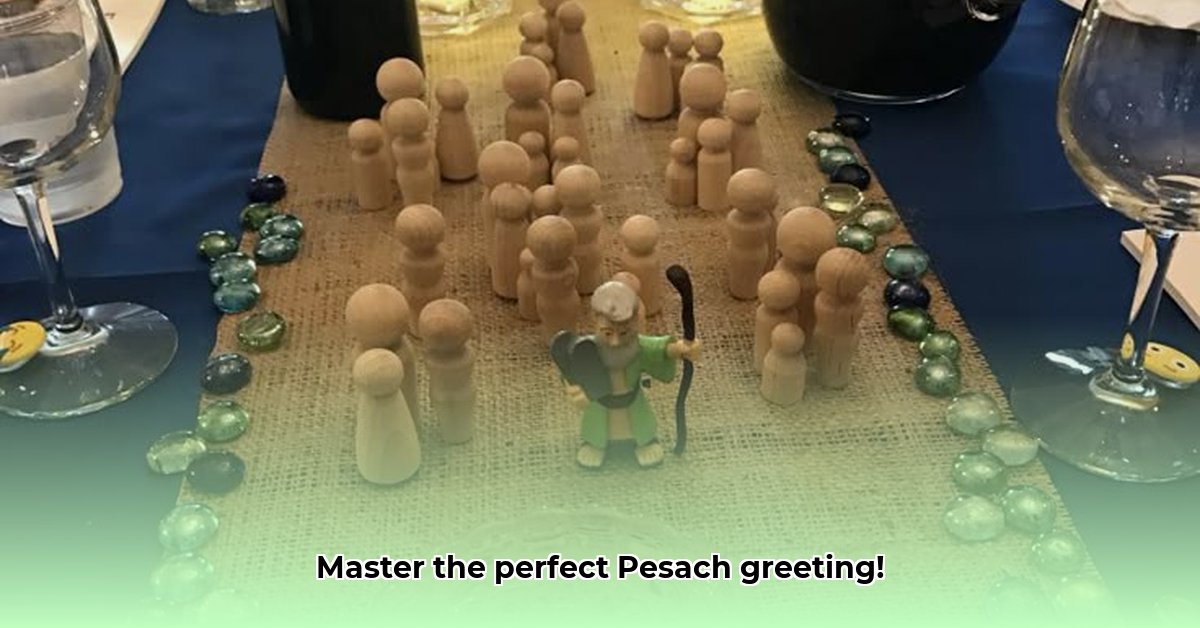Want to wish someone a heartfelt “Happy Passover”? It might seem a little complex with all the different greetings and languages, but this comprehensive guide will make it easy. We’ll break down the most common Passover greetings in Hebrew, Yiddish, Ladino and even English, showing you exactly when to use each term, the proper pronunciations, and the cultural context. By the end, you’ll be a Passover greeting pro, ready to impress your friends, family, and colleagues with your newfound knowledge. Let’s get started!
Understanding Passover Greetings: More Than Just Words
Passover Wishes, Holiday Greetings, Jewish Culture
Passover greetings are more than just words. They are a way to connect with people, to show respect, and to express your understanding of this important holiday. Choosing the right greeting can make all the difference.
Hebrew Greetings: Connecting to the Heart of the Holiday
Happy Passover in Hebrew, Pesach Traditions, Hebrew Phrases
The most common way to say “Happy Passover” in Hebrew is Pesach Sameach (פֶּסַח שַׂמֵחַ). It’s simple, friendly, and conveys your wishes perfectly. Think of it as the “Happy Birthday” equivalent for Passover. Need something a bit more formal? Then try Chag Pesach Sameach (חַג פֶּסַח שַׂמֵחַ). Adding “Chag,” which means “holiday,” gives it a more formal feel, like saying “Happy Holidays” instead of “Merry Christmas.” Both are perfectly appropriate; it just depends on the situation and your relationship with the person you are greeting.
To add a unique touch that shows you really understand the holiday, include “Kasher v’Sameach” (כָּשֵׁר וְשָׂמֵחַ), which means “kosher and happy.” This acknowledges the importance of keeping kosher during Passover. You would say Chag Pesach Kasher v’Sameach (חַג פֶּסַח כָּשֵׁר וְשָׂמֵחַ). It’s a thoughtful way to show you know what Passover is all about.
Yiddish Greetings: A Warm and Historic Tradition
Yiddish Greetings, Gut Yom Tov Meaning, Ashkenazi Culture
Yiddish, a language with deep roots in Eastern European Jewish culture, offers its own unique greetings. “Gut Yom Tov” (גוט יום טוב) is a widely used phrase that means “Good Holiday.” It’s a versatile greeting, suitable for many Jewish holidays, not just Passover.
For Passover specifically, “Gut Yom Tov” is best used on the first two and the last two days of Passover (Yom Tov). For the intermediate days, called Chol Hamoed, you would use “Gut Mo’ed” (גוט מועד), which means “Good Intermediate Days.” This demonstrates that you’re not just vaguely saying “Happy Passover,” but that you understand the structure and traditions of the holiday itself. The Yiddish post-Passover greeting is “a gezuntn zumer,” meaning “a healthy summer.”
Ladino Greetings: Honoring Sephardic Heritage
Sephardic Passover, Ladino Greetings, Jewish Diaspora
For those with Sephardic heritage, consider using “Feliz Pesah” which translates directly to “Happy Passover” in Ladino. This is a thoughtful and culturally sensitive way to acknowledge and honor their unique traditions.
Beyond the Words: Mastering Pronunciation and Etiquette
Passover Etiquette, Pronunciation Guide, Cultural Sensitivity
Pronunciation is key for Hebrew, Yiddish and Ladino greetings! The “ch” sound in Hebrew and Yiddish isn’t quite the same as the English “ch.” It’s a guttural sound, similar to the “ch” in the Scottish word “loch” or the German word “Bach.” Listen to native speakers online or use a pronunciation guide to ensure accuracy. Getting the pronunciation right shows respect and effort.
Consider your audience. A formal “Chag Pesach Sameach” or “Chag Pesach Kasher v’Sameach” is perfect for older relatives, community leaders, or people you don’t know well. A more casual “Happy Passover” or “Pesach Sameach” works great for friends and close family. Tailor your greeting to the relationship and the situation.
Your Comprehensive Passover Greeting Cheat Sheet
Here’s a handy table summarizing the greetings we’ve discussed, along with pronunciations:
| Language | Greeting | Meaning | Pronunciation (approximate) | Best Used For |
|---|---|---|---|---|
| Hebrew | Pesach Sameach | Happy Passover | PAY-sakh sah-MAY-akh | Informal, any day of Passover |
| Hebrew | Chag Pesach Sameach | Happy Passover Holiday | KHAG PAY-sakh sah-MAY-akh | More formal, any day of Passover |
| Hebrew | Chag Pesach Kasher v’Sameach | Happy Kosher Passover Holiday | KHAG PAY-sakh kah-SHEHR vuh-sah-MAY-akh | Formal, shows understanding of kosher |
| Yiddish | Gut Yom Tov | Good Holiday | GUT YOM TOV | First two & last two days of Passover (Yom Tov) |
| Yiddish | Gut Mo’ed | Good Intermediate Days | GUT MOY-ed | Chol Hamoed (intermediate days) |
| Ladino | Feliz Pesah | Happy Passover | Fe-LEEZ Pe-SAKH | Sephardic communities |
| English | Happy Passover | Happy Passover | N/A | Universally understood, informal |
| Yiddish | A gezuntn zumer | A healthy summer | A geh-ZUN-ten ZOO-mer | Post-Passover greeting |
Mastering these greetings shows respect for Passover traditions and creates meaningful connections. Your Passover greeting becomes more than a simple phrase. It becomes a bridge of understanding and warmth. So, go forth and wish everyone a truly heartfelt Chag Sameach Pesach!
The Art of Choosing the Right Passover Greeting: Ashkenazi, Sephardic, and Beyond
Ashkenazi Passover Greetings, Sephardic Passover Greetings, Inclusive Greetings
Choosing the right Passover greeting goes beyond simply saying “Happy Passover.” It’s about cultural sensitivity and an appreciation for the diverse tapestry of Jewish traditions. Let’s explore how to navigate this delightful complexity.
Understanding the Nuances of Jewish Culture
Jewish Customs, Cultural Sensitivity, Jewish History
Jewish communities, like all communities, have diverse customs and traditions that have evolved over centuries. Ashkenazi Jews, predominantly of Central and Eastern European descent, have a history deeply intertwined with Yiddish. Sephardic Jews, originating from the Iberian Peninsula and the Mediterranean, have a unique cultural identity reflected in Ladino and their customs. These differences are beautifully expressed, even in the simplest of greetings.
Key Takeaways:
- “Chag Pesach Sameach” (Happy Passover Holiday) is universally understood and a safe bet for most situations.
- Consider your relationship with the recipient; a close friend might receive a more informal greeting than a distant acquaintance.
- Knowing whether someone is Ashkenazi or Sephardic can guide your choice towards more culturally specific greetings (although “Chag Pesach Sameach” is almost always appropriate).
- The day of the holiday matters. Greetings may vary slightly between the main holy days (Yom Tov) and the intermediate days (Chol Hamoed).
- Adding “Kasher” (as in “Chag Kasher v’Sameach”) expresses a wish for a religiously observant Passover, which can be a thoughtful touch for those who keep kosher.
Common Passover Greetings: A Quick Reference Guide
Passover Greetings Guide, Hebrew Passover Greetings, Yiddish Passover Greetings, Ladino Passover Greetings
Here’s a breakdown of common greetings, taking into account cultural context:
| Greeting | Language | Meaning | Context |
|---|---|---|---|
| Chag Pesach Sameach | Hebrew | Happy Passover Holiday | Suitable for most occasions, across both Ashkenazi and Sephardic communities. |
| Chag Kasher v’Sameach | Hebrew | Happy and Kosher Passover | Ideal for those who keep kosher and observe traditional practices. |
| Feliz Pesah | Ladino | Happy Passover | Typically used within Sephardic communities. |
| A Gutten Pesach | Yiddish | A Good Passover | Common among Ashkenazi Jews. |
| Gut Yom Tov | Yiddish | Good Holiday | Used on the first and last days of Passover (Yom Tov) within Ashkenazi communities. |
| Gut Mo’ed | Yiddish | Good Intermediate Days | Used during Chol Hamoed (intermediate days) within Ashkenazi communities. |
| Happy Passover | English | Simple and widely understood. | A safe and inclusive option, especially in diverse settings. |
Making the Right Choice: A Step-by-Step Approach
Choosing Passover Greetings, Passover Holiday Wishes, Thoughtful Greetings
1. Consider the Recipient: Are you close friends with the recipient, or are
- Good Morning Bestie Meme Shares Morning Smiles With Friends - November 21, 2025
- Happy Morning Meme Helps You Start Your Day with Laughter - November 20, 2025
- Good Morning Memes Funny for Friends to Kickstart Their Day With Laughter - November 19, 2025










